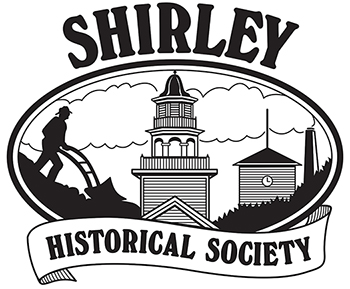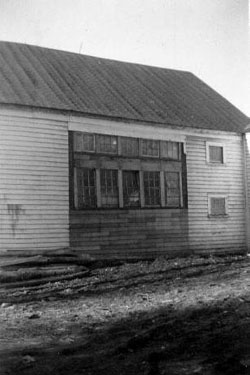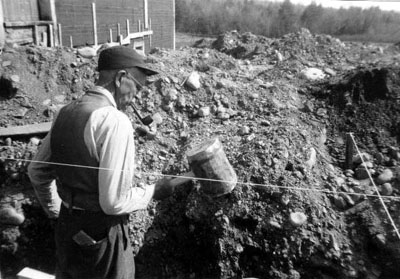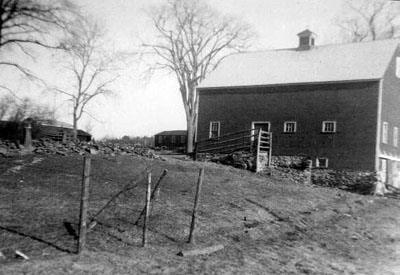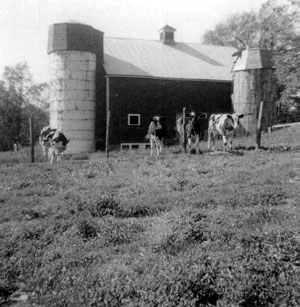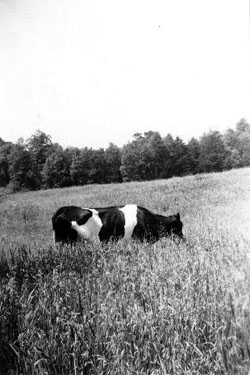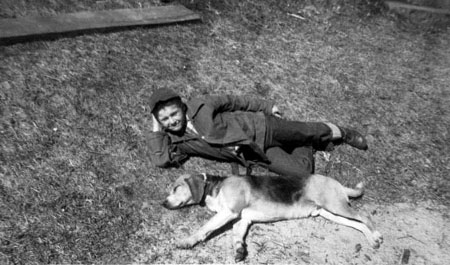As the herd grew it became evident that milking machines would be a great time and energy saver. They had a salesman come and instruct them on how to use the different kinds of machines. Some cows were skittish – they didn’t like the surcingles across their back – so they decided on the DeLaval machines. Some of the older cows, that were used to hand milking, had to be finished by hand (stripped) but young first-calf heifers could usually be trained to let down all their milk for the machine.
At about this time it was apparent that the cows’ horns presented some problems. While most of the critters were gentle, some of them could be really mean to each other and the men folks decided they should be de-horned. This was done by the Vet, Dr. Fitzgerald, with his de-horner, which is similar to a bolt cutter. Before he removed the large horns, pieces of rubber inner tube were put around the cows’ two polls to control the bleeding. About two hours after the horns were removed, the rubbers were cut off.
This proved to be a rather unpleasant experience for both cow and farmer, so they began the practice of using caustic potash to kill the skin around the little ‘horn buttons’ when calves were three or four days old. As a result, their horns never grow.
For several years the milkers were all at the Homestead. The barns were re-modeled, the chicken house section converted, and stanchions and other necessary equipment put in. Gradually every available corner was used for housing dry cows and young stock. The overflow of non-milking animals was soon moved over to the Whitney Road barn.
It was decided to build on to the barn at Meadowcroft (re-named Longley Acres) and Melvin and Howard, with the help and suggestions of the Extension Service and some neighboring farmers, made up plans and started building in the spring of 1954. Everyone helped, including Louise’s father, an engineer, who came on from New Jersey to have a hand in the project. Pictured below is George Hitchcock using the mallet made by Melvin and familiarly known as ‘Egbert’.
Not long after the stock was settled, it was necessary to plan some sort of fire protection, as there was no town water down Whitney Road. Dick Hatch and a crew were hired to dig a pond in the field below the barn. This worked out fine as a drinking place for the herd. After digging it to the desired requirements the Fire Department came with their equipment and tested the accessibility and found it to be a sensible addition to the farm.
Photo below shows barn before 1954 construction.
After a year or two the pond was stocked with blue gill and bass fingerlings. When the fish had grown large enough, the children and their friends enjoyed fishing them out and eating them.
A regular spring chore is to check out and mend pasture fences. This is a time when wildflowers and shrubs begin to leaf out. Melvin and the children could always be depended on to bring home blossoms of anemones, cinque foil, bluets or mayflowers when they had been fence mending.
As the years go by it becomes more and more difficult to find suitable fence post material. While chestnut was available it was the most desirable, long-lasting wood, along with locust. More recently they have had to settle for maple and ash and other kinds which have a relatively short life of usefulness.
Aside from the wooden barnyard fences the fences were strung with barbed wire.
Electric fences were used for a while but were not always satisfactory. Cows learned how to scooch under the single strand and so a strand of barbed wire had to run below the electric one. Also, a fallen limb on the electric fence could put the whole circuit out of commission. Once Melvin called the whole family out to hear the radio music that had been mysteriously routed through the fence.
After struggling with the problems for several years they decided to place a three-stranded barbed wire fence around most of the pastures. Alot of the fields were edged by old stone walls, but these were not high enough to hold the large holsteins.
Barbed wire fences require alot of maintenance – posts rot out and wires slacken or break. Most years about 150 new posts are put in.
Sometime along in the fifties, Melvin noticed that a hawk, on the sidelines, often watched him as he worked. As he moved along the fence the hawk would fly to a nearby post or trees seemingly interested in the whole process. Each year, for quite a number of seasons, this happened. Sometimes it would observe other of Melvin’s farm activities, and Melvin got so he looked forward to seeing his friend when he was working out of doors. In looking through a bird book it was found that the curious bird was a Cooper’s Hawk.
Occasionally a heifer comes along that refuses to be fenced in. If there is the smallest opening or loose section in the wires she will be the one to find it and there will be the devil to pay. This usually happened after dark and got the whole family out (and sometimes a neighbor or two) to corral the critter and got her back into the pasture. Then the fence had to be mended right away, no matter how tired everyone was. Once or twice the whole herd escaped this way and thundered through a neighbors garden, and another time they went up onto the Common to prance about.
Cathy wrote the following note to her mother in 1957 when Louise was visiting her parents in New Jersey:
“Dear Mom,The day is only half over and there’s been plenty of excitement already. At 6 a.m. Mrs. Choate (nextdoor neighbor) called and finally got it through to Daddy that the cows were in her garden. Here’s what she said, “Please come. Oh, hurry. There’s at least a million of them”.
So Daddy raced up there with the three oldest boys trailing behind him. When they were about halfway there, Mrs. Choate called again and I answered. She said, “Is your husband coming? Is he on his way?” I didn’t bother to tell her who I was, but told her he was coming.
Gramma also got a call so she was here to help. After getting the cows out of every nook and corner, we finally got them in the barn. Jonny said Mr. Choate said it was the most horrible thing he ever saw.
Now Daddy’s killing a chicken for the Choates to relieve their fears and steam (blowing off steam).
Love, P.S.: Now he went up to take the manure out of Choate’s garden.”Cathy
A real exciting day on the farm!
Driving in the cows was the first chore in good weather. Usually the animals were anxious to go in and be milked and fed. There was usually one cow that was the leader, just as there was always the same one or two who straggled in last.
During summer the first order of business was spraying for flies. Then they were fed their grain before milking.
Manure was put in a pile to be spread the first thing in the spring. This was an enormous job and after a few years they decided to spread daily – unless the weather was too violent. This helped the morale come spring, as there would be no huge pile awaiting them and the fields would be all ready for their summer growth. There was one persistent salesman who came regularly and never seemed to realize that the men had to keep on with their chores. One day, after he watched them load the manure, he followed the spreader up on to the field even after Melvin had started the beater going.
In good weather a cow was allowed to calve out in the pasture and the family would take turns checking on her. Calving pens were provided in the barn during the winter. Generally any bull calves were sold for veal soon after birth and heifers were kept to raise if their dam’s milk record warranted it.
Sometimes calves or older cows were traded for farm equipment with Eddie Willard of Leominster. This is where Melvin first got his interest in becoming a tractor mechanic.
One spring several farmers brought a dry cow or two to fill up the pasture for the summer. When it was time to take the animals home in the fall, there was one cow left that noone claimed. The Longleys were certain that it belonged to one of those farmers, but he insisted that he had never seen the animal before. That is how the family acquired Old Cow, a grade holstein with crooked horns. She lived as part of the Longley herd, producing well, for a number of years.
One cattle dealer paid visits to the farm periodically and would greet us with “Have you got anything for a poor man today?” If a deal was made, he’d reach in his pocket (which went down almost to his knees) and pull out a roll of bills. We wondered how much money he carried around with him.
What fun it is to watch the cows on their first day out in the pasture. They would kick up their heels and run around the fields in child-like pleasure after the long winter of confinement. After their romp they would soon settle down to eating the nice green grass. You had to be careful they didn’t eat too much at first, for two reasons – 1. they could bloat and become sick or 2. it could make their milk taste grassy – a condition not appreciated by consumers. One source of amusement to Howard and Melvin one spring was, when the dairy mailed them a notice that the milk had a grassy taste – before the cows had been turned out.
A farm can’t get along without a cat and dog; the cat to tend to mice in the barn. The dog was always companion to the family and was ‘in on’ most farm activities. Sometimes if a strange pooch decided to pester the cows and get them running, our hound would bark the alarm and the family would help him drive the offenders away.
Then, too, a good woodchucker dog is handy. Thumper and Mose, in their time, kept the woodchuck population down. When Thumper was chief dog, the family kept track of his catches. When he brought in his 100th woodchuck, the family took him up to Clover Hill stand and bought him a hot dog.
Milk was first sent to J.B. Prescott’s Dairy in Bedford in 1940 and brought about 3¢ a quart.
When Howard first had his small herd he stored the milk in 8-quart cans in a section of the watering trough. Ice from the ice house was used in hot weather to cool the milk. When they started selling to Prescott, the milk was strained into 40-quart jugs and put into the refrigerated milk cooler. When the jugs became worn, they had to be sent to Everett, Mass. to be re-tinned.
Prescott’s truck would pick up the 4 or 6 jugs every other day. The cooler held 6 jugs so, when production got up to 6 jugs, two of the cold ones were removed and insulated jackets put over them to keep them cool.
When the new barn was built at Longley Acres, a larger milk cooler was installed that would hold 10 jugs and, four years later, in 1956, a Zero bulk tank was needed – this held 440 gallons. 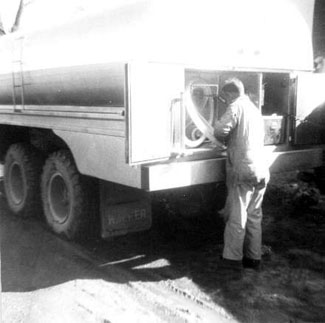 This was picked up every other day by the Suburban Dairy bulk tank truck from Chelmsford.
This was picked up every other day by the Suburban Dairy bulk tank truck from Chelmsford.
A dip stick, similar to those used to measure oil in your car, with markings every inch, measured the milk, and by referring to the calibration charts you could tell how many pounds of milk were in the tank. (A pint’s a pound the world around.) Every two or three years the Sealer of Weights and Measures would spend a few hours checking the accuracy of the chart.
In the later years of the dairy enterprise a transfer station was put to use for getting milk to the cooler. This saved alot of steps back and forth to the milk room. The milk was dumped directly into this damping station on wheels and pumped by plastic pipe line directly to the cooler. The station and pipe had to be thoroughly washed with a special cleaner.
Milk pails and strainers were washed twice a day and the bulk tank was scalded and scrubbed after every pickup by the milk tank truck. The machines dismantled and pulsator parts cleaned every three days.
Milk checks were sent every two weeks and were based on quantity and butterfat content. While holsteins are known to be heavy producers, their milk generally does not average more than 3.7 butterfat content. This explains why a holstein farmer usually keeps two or three Jerseys or Guernseys – to bring up the fat average.
